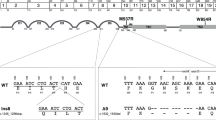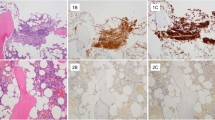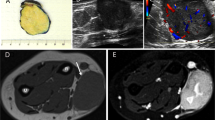Abstract
Mastocytosis Is characterized by accumulations of mast cells in various organs1. Most cases are indolent and confined to the skin, where discrete mast cell infiltrates are associated with increased epidermal melanin, a clinical picture known as urticaria pigmentosa (UP). Other forms of mastocytosis combine UP with aggressive involvement of other organs or with haematologic abnormalities1–4. It is not known whether all forms of mastocytosis are true neoplasms or whether some might represent reactive hyperplasias5–7. The c-KIT proto-oncogene encodes a type III receptor tyrosine kinase (KIT) that is critical to the development and survival of mast cells and melanocytes8–11. The ligand for KIT (KL) can stimulate mast cell development, proliferation, and mediator release9,12–17, as well as melanocyte proliferation and pigment production18–20. To determine the role of c-KIT in the pathogenesis of mastocytosis, we examined tissue and cells isolated from a patient with UP and aggressive systemic mastocytosis with massive splenic involvement. We found a mutation that results in constitutive activation and expression of c-KIT in mast cells of both skin and spleen. This is the first in situ demonstration of an activating c-KIT mutation in neoplastic cells. It also demonstrates the clonal and neoplastic nature of this form of mastocytosis.
This is a preview of subscription content, access via your institution
Access options
Subscribe to this journal
Receive 12 print issues and online access
We are sorry, but there is no personal subscription option available for your country.
Buy this article
- Purchase on SpringerLink
- Instant access to full article PDF
Prices may be subject to local taxes which are calculated during checkout
Similar content being viewed by others
References
Longley, B.J., Duffy, T.P. & Kohn, S. The mast cell and mast cell disease. J. Am. Acad. Dermat. 32, 545–561 (1995).
Travis, W.D., Li, C.-Y., Bergstralh, E.J., Yam, L.T. & Swee, R.G. Systemic mast cell disease: analysis of 58 cases and literature review. Medicine 67, 345–368 (1988).
Travis, W.D., Li, C.-Y., Hoagland, H.C., Travis, L.B. & Banks, P.M. Mast cell leukemia: report of a case and review of the literature. Mayo Clinic Proc. 61, 957–966 (1986).
Metcalfe, D.D. Classification and diagnosis of mastocytosis: current status. J. Invest. Dermat. 96, 2S–4S (1991).
Galli, S.J. New concepts about the mast cell. N. Engl. J. Med. 328, 257–265 (1993).
Longley, B.J., et al. Altered metabolism of mast-cell growth factor (c-kit ligand) in cutaneous mastocytosis. N. Engl. J. Med. 328, 1302–1307 (1993).
Longley, J. Is mastocytosis a mast cell neoplasia or a reactive hyperplasia? Ann. Med. 26, 115–116 (1994).
Yarden, Y. et al. Human proto-oncogene c-kit: a new cell surface receptor tyrosine kinase for an unidentified ligand. EMBO J. 6, 3341–3351 (1987).
Qiu, F.H. et al. Primary structure of c-kit: relationship with the CSF-1/PDGF receptor kinase family – oncogenic activation of v-kit involves deletion of extracellular domain and C terminus. EMBO J. 7, 1003–1011 (1988).
Geissler, E.N., Ryan, M.A. & Housman, D.E. The dominant-white spotting (W) locus of the mouse encodes the c-kit proto-oncogene. Cell 55, 185–192 (1988).
Chabot, B., Stephenson, D.A., Chapman, V.M., Besmer, P & Bernstein, A. The proto-oncogene c-kit encoding a transmembrane tyrosine kinase receptor maps to the mouse W locus Nature 335, 88–89 (1988).
Anderson, D.M. et al. Molecular cloning of mast cell growth factor, a hematopoietin that is active in both membrane bound and soluble forms. Cell 63, 235–243 (1990).
Tsai, M. et al. The rat c-kit ligand, stem cell factor, induces the development of connective tissue-type and mucosal mast cells in vivo Analysis by anatomical distribution, histochemistry, and protease phenotype. J. Exp. Med. 174, 125–131 (1991).
Galli, S.J. et al. Reversible expansion of primate mast cell populations in vivo by stem cell factor J. Clin. Invest. 91, 148–152 (1993).
Sperr, W.R. et al. Specific activation of human mast cells by the ligand for c-kit: comparison between lung, uterus and heart mast cells. Int. Arch. Allergy Appl. Immun. 102, 170–175 (1993).
Columbo, M. et al. The human recombinant c-kit receptor ligand, rhSCF, induces mediator release from human cutaneous mast cells and enhances IgE-dependent mediator release from both skin mast cells and peripheral blood basophils. J. Immunol. 149, 599–608 (1992).
Takagi, M. et al. Stimulation of mouse connective tissue-type mast cells by hemopoietic stem cell factor, a ligand for the c-kit receptor. J. Immun. 148, 3446–3453 (1992).
Halaban, R., Tyrell, L., Longley, J., Yarden, Y & Rubin, J. Pigmentation and proliferation of human melanocytes and the effects of melanocyte-stimulating hormone and ultraviolet B light. Ann. N. Y. Acad. Sci. 680, 290–301 (1993).
Funasaka, Y. et al. C-kit-kinase induces a cascade of protein tyrosine phosphorylation in normal human melanocytes in response to mast cell growth factor and stimulates mitogen-activated protein kinase but is down-regulated in melanomas. Mol. Biol. Cel 3, 197–209 (1992).
Harrist, T.J. et al. Recombinant human stem cell factor (SCF) (c-kit ligand) promotes melanocyte hyperplasia and activation in vivo. Lab. Invest. 72, 48A (1995).
Furitsu, T. et al. Identification of mutations in the coding sequence of the proto-oncogene c-kit in a human mast cell leukemia cell line causing ligand-independent activation of c-kit product. J. Clin. Invest. 92, 1736–1744 (1993).
Butterfield, J.H., Weiler, D., Dewald, G. & Gleich, G.J. Establishment of an immature mast cell line from a patient with mast cell leukemia. Leuk. Res. 12, 345–355 (1988).
Nagata, H. et al. Identification of a point mutation in the catalytic domain of the protooncogene c-kit in peripheral blood mononuclear cells of patients who have mastocytosis with an associated hematologic disorder. Proc. Natl. Acad. Sci. USA 92, 10560–10564 (1995).
Longley, J. et al. Isolation, detection, and amplification of intact mRNA from dermatome strips, epidermal sheets, and sorted epidermal cells. J. Invest. Dermat. 97, 974–979 (1991).
Tyrrell, L., Elias, J. & Longley, J. Detection of specific messenger RNAs (mRNA) in dermatopathology specimens: effects of different fixatives and implications for diagnosis and research. Am. J. Dermatopath. 17, 476–483 (1995).
Tsai, M., Miyamoto, M., Tam, S.-Y., Wang, Z.-S. & Galli, S.J. Detection of mouse mast cell-associated protease mRNA. Heparinase treatment greatly improves RT-PCR of tissues containing mast cell heparin. Am. J. Path. 146, 335–343 (1995).
Author information
Authors and Affiliations
Rights and permissions
About this article
Cite this article
Longley, B., Tyrrell, L., Lu, SZ. et al. Somatic c-KIT activating mutation in urticaria pigmentosa and aggressive mastocytosis: establishment of clonality in a human mast cell neoplasm. Nat Genet 12, 312–314 (1996). https://doi.org/10.1038/ng0396-312
Received:
Accepted:
Issue Date:
DOI: https://doi.org/10.1038/ng0396-312



